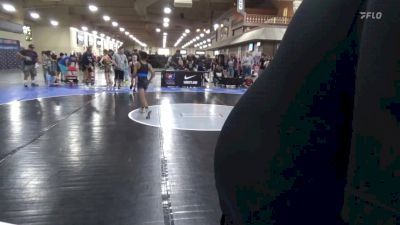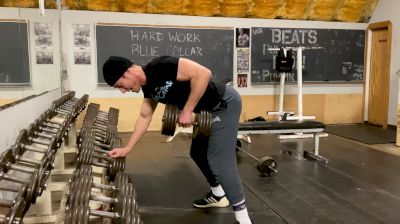Coach Myers Wrestling S&C: 3 Row Movements
Coach Myers Wrestling S&C: 3 Row Movements
Having a strong upper back is crucial for wrestling, and every strength program should incorporate a variety of rowing movements.
Unlock this article, live events, and more with a subscription!
Already a subscriber? Log In
Having a strong upper back is crucial for wrestling, and every strength program should incorporate a variety of rowing movements.
The row is one of the most basic and effective exercises for upper back size and strength. Despite its simplistic nature, it is still a movement done wrong by many, even experienced weightlifters. The goal of any row movement is to utilize the lats, rhomboids, and traps to retract the scapula as you pull the weight up to your abdomen.
Here are some of the most common mistakes:
- Using too much bicep: The bicep acts as an accessory on any rowing movement, but if you focus on pulling your elbow back towards the hip you will minimize the role of the bicep and let those big upper back muscles do the work.
- Uneven hips or curved spine: Like most strength movements, your stance and spinal position during the DB Row is of the utmost importance. Keeping a straight back in a powerful position is key, so avoid rowing with your feet uneven/staggered or with one leg up on a bench. The “one knee on a bench” position is going to put your hips in an uneven position — not a good idea when pulling on a heavy weight. Stand with your feet shoulder-width and bend forward at the waist, keeping a flat back. Put one hand on a rack or bench in front of you and imagine that you could draw a symmetrical box between the four points of your feet and hands.
- Twisting up then dropping the weight: Try not to twist away from the dumbbell as you pull — that creates the illusion that you have pulled it up higher than you actually have. Make sure to lower the weight under control, as the eccentric portion of the row is the most important for gaining size and strength.
DB Row
Bend over and grab a dumbbell with your other hand on a bench or rack for support. Keep your feet square rather than staggered and your spine straight, and head in a neutral position. Pull the weight up and back towards your hip as you retract the scapula and squeeze the muscles in the middle of your back. Do not twist — try to keep your shoulders level. Lower under control and allow the lat to stretch at the bottom.
Rx: Start with 3 sets of 5-8 reps per side.
The Barbell Row is another great movement for upper back strength, but because it is traditionally done unsupported, the small spinal erectors of the lower back become the limiting factor in how much weight can be utilized.
The most common mistakes include jerking the weight up or losing stability through the hips and low back. Because of the large room for error in form, I generally don’t use an unsupported barbell row with my athletes. Instead I opt for what I call “dead stop rows.” This is an intense barbell row done lying prone on a bench with a medium weight, focusing on the isometric squeeze at the top.
Dead Stop Row
Lay face down on a bench with a light-medium weight barbell (40-50 percent of bodyweight) underneath you. Keeping your spine straight; row the weight up explosively until it crashes into the bench. Once there, hold the contraction for 3 seconds before lowering the weight. Because of the emphasis on speed (concentric) and then the isometric contraction, you can lower the weight fast or even drop it between reps rather than emphasizing the eccentric. Imagine that you are “bending the bar” around the bench, actively pulling it the entire time other than just holding at the top. This will help build immense squeezing strength in this position.
Rx: 3 sets of 5 reps, each for a 3 count pause
While the first two rowing movements are focused on scapular retraction while the trunk is in a stable position, this next movement is what is known as an anti-rotational movement. Doing “anti-rotational movements,” there is an unbalanced (right to left) element that forces your core to stabilize and fight against the rotational force being applied to it. In the case of a Band Plank Row, the row itself comes secondary to the anti-rotational core strength required to keep your hips in good position. I love this movement as a core accessory for wrestlers because it helps build core strength in a position they will find themselves in on the mat — uneven support and pulling with one arm.
Plank Band Row
Get into a plank position with a band attached to a low rack in front of you. Grab the band with your arm fully extended and tension on the band. Perform a row, pulling your elbow towards your hip while maintaining proper alignment (do not raise or twist your hips). Repeat for both sides.
Rx: I like to program sets of 8-12 reps per side, typically as an “active recovery” in between weighted chin-ups, DB Rows, or even heavy pressing movements.
Coach Myers is the strength coach for the Ohio Regional Training Center at The Ohio State University. With the Ohio RTC since 2012, he served as Ohio State Wrestling’s primary strength coach from 2014-18, helping the Buckeyes win three Big Ten titles, their first-ever team NCAA championship, and two runner-up finishes.
A certified strength and conditioning specialist (CSCS), Coach Myers owns the Old School Gym in Pataskala, OH, and is a founding partner of top supplement company Max Effort Muscle. Follow him on Instagram and Facebook, and learn more about his strength and conditioning programs for wrestlers of all ages here.
Related Content
 Hayden Schwab Wants To Make A Freestyle World Team After Winning Greco
Hayden Schwab Wants To Make A Freestyle World Team After Winning GrecoApr 26, 2024
 Replay: Mat 11 - 2024 US Open Wrestling Championships | Apr 25 @ 4 PM
Replay: Mat 11 - 2024 US Open Wrestling Championships | Apr 25 @ 4 PMApr 26, 2024
 Replay: Mat 3 - 2024 US Open Wrestling Championships | Apr 25 @ 4 PM
Replay: Mat 3 - 2024 US Open Wrestling Championships | Apr 25 @ 4 PMApr 26, 2024
 Replay: Mat 8 - 2024 US Open Wrestling Championships | Apr 25 @ 4 PM
Replay: Mat 8 - 2024 US Open Wrestling Championships | Apr 25 @ 4 PMApr 26, 2024
 Replay: Mat 12 - 2024 US Open Wrestling Championships | Apr 25 @ 4 PM
Replay: Mat 12 - 2024 US Open Wrestling Championships | Apr 25 @ 4 PMApr 26, 2024
 Joseph Jeter Makes Up His Own Moves & Makes A World Team
Joseph Jeter Makes Up His Own Moves & Makes A World TeamApr 26, 2024
 Evan McGuire Only Had 2 Greco-Practices Before Making The U17 World Team
Evan McGuire Only Had 2 Greco-Practices Before Making The U17 World TeamApr 26, 2024
 Dom Munaretto Wants To Make Two World Teams This Year
Dom Munaretto Wants To Make Two World Teams This YearApr 26, 2024
 Replay: Mat 15 - 2024 US Open Wrestling Championships | Apr 25 @ 4 PM
Replay: Mat 15 - 2024 US Open Wrestling Championships | Apr 25 @ 4 PMApr 26, 2024
